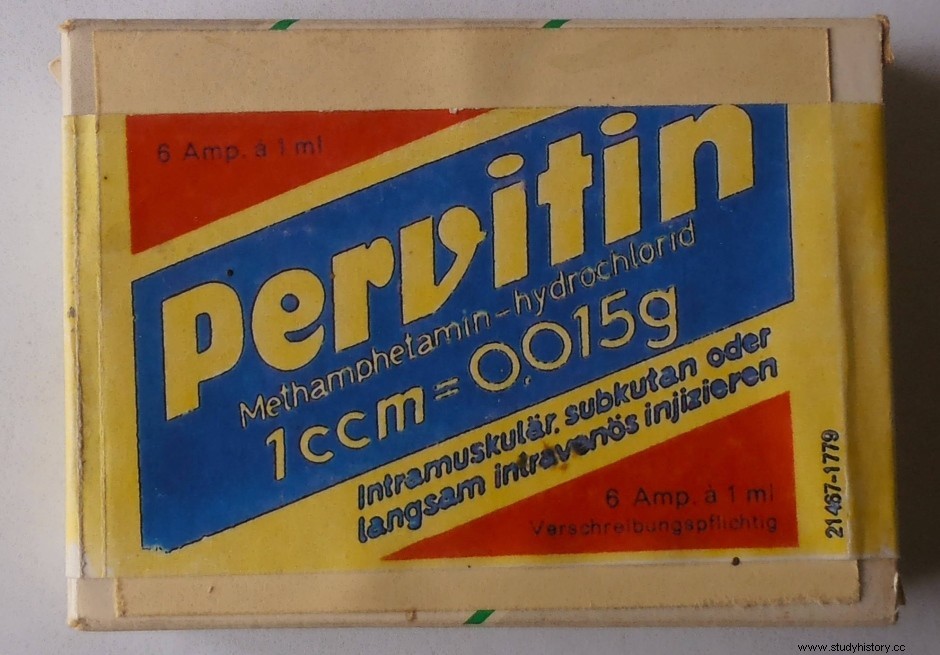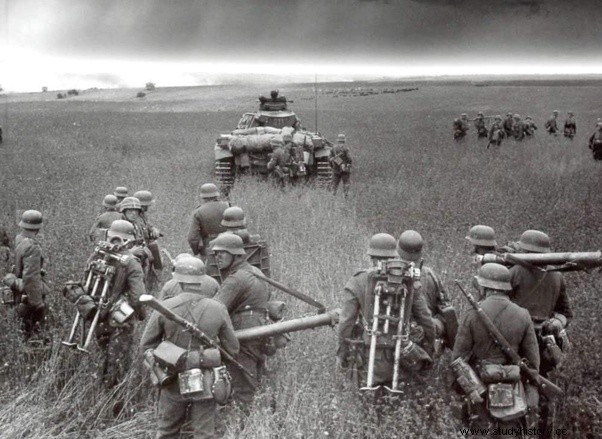The consumption of narcotic substances has been widespread among the different human societies since its origins. All kinds of drugs of different use and effect are used or have been used in a common way. The most legally used drugs today are caffeine, alcohol, and nicotine. Substances related to leisure, such as cocaine, LSD, heroin or methamphetamine are widely used today, despite being illegal drugs. The legality or illegality of the drugs consumed by man has been changing according to their social acceptance and their effects on the human body.

In 1938, the Berlin pharmaceutical company Temmler put a methamphetamine preparation on the market under the name of Pervitin . Pervitin was sold as a pick-me-up for long hours at work and to keep you awake and focused during evenings studying. Although sold in pharmacies, this pill was sold without any prescription.

The chemical formula had been acquired in Japan a few years earlier. Temmler Pharmaceuticals tested it on laboratory rats and found that the main reaction was excessive excitement in the animals. Temmler therefore decided to market it as exciting to humans. Sold in tubes of between 12 and 20 doses, Pervitin tablets could be consumed every 8 hours and allowed to work without rest for 3 days in a row.

Due to the trust produced by a product for legal sale and in addition to a German invoice, the consumption of Pervitn spread rapidly among society. Anyone took it to have more energy and be more productive during their day-to-day chores. Just as it was okay to have a coffee to clear your head, so was a Pervitin pill. This drug was not associated with leisure or drug addiction. As its name Pervitin indicated, which came from the Latin per vite -for life- was for day to day.
The drug became so popular among the Germans that products containing Pervitin were even produced. The most famous was Hildebrand brand chocolate. This Berlin-based chocolate company had a product called Scho-Ka-Kola , which had cocoa, coffee, caffeine and cola. During the war, two varieties with doses of Pervitin were developed, called Panzerschokolade and Fliegerschokolade . Marzipan was also produced with Pervitin, which received the name of Fliegermarzipan .

The effects of Pervitin also drew the attention of the German armed forces.The head of the military medical academy, General Otto Ranke realized the possibilities offered by Pervitin. After conducting an experiment on recruits in which two groups of soldiers faced a sleepless night of grueling mental work and the group taking Pervitin was extremely efficient, the Wehrmacht started buying the drug in industrial quantities.

The invigorating pills were distributed among the troops in both the Polish and French campaigns. In France, in addition to thanks to the superiority of German tactics, the possibility of being able to march for days without rest led to the rapid fall of the Gallic country. French officers calculated the distances the Germans could travel according to normal parameters, not that of drugged soldiers. There are many reports where it is highlighted that the Germans appear in different positions of the front hours or even days earlier than expected by military intelligence.
Despite the obvious benefits produced by the consumption of Pervitin, by 1940 the side effects were already beginning to prove dire. The health minister Leonardo Conti, a staunch defender of race theories, disdained the effects produced by continued consumption of Pervitin. Some medical reports from psychiatric hospitals had already appeared, where up to 10% of the inmates were there due to repeated use of the substance. By express order of the minister, methamphetamine addicts would be eliminated in the context of operation T4, considering them racially impure.

Conti ordered that from June 1941 the consumption of Pervitín be prohibited to the civilian population except under medical prescription. Consumption for the armed forces was also limited, except in cases of extreme necessity. Despite the express orders of the minister, the limitation was not only not ignored, but consumption was increased. By the end of 1941, Temmler increased its production to 600,000 doses per day and was forced to build a second production plant to supply the army.

Due to the great German dependence on methamphetamine, the regime was forced to develop a new drug that would not produce side effects to those who consumed it. In 1944 the war was lost, but the Nazi leaders refused to admit the evidence. In the final impasses of the world war, Nazi scientists are under increasing pressure to develop miracle weapons that will enable the German Reich to win the war.
A new weapon that was thought to have a decisive impact on naval warfare was the mini-submarine . Different models were manufactured, such as the Neger or the Molch , which had a crew of 1 or 2 crew members and due to their small size were undetectable. The crew of these vehicles was locked in a small cabin for hours, with a very narrow space to move and with the continuous noise of the engine echoing throughout the boat.

Operating under these conditions was impossible, so the SS doctors at the Sachsenhausen concentration camp in Berlin were tasked with developing an even better drug than Pervitin. For this they used camp prisoners as guinea pigs. Between November 17 and 20, 1944, four different drugs were tested on 12 inmates :liquid cocaine, powder cocaine, chewable cocaine and methamphetamine. The prisoners were forced to march through the camp's parade ground for four days without stopping, carrying a 30-kilo sack.

The prisoners held out for a minimum of three days. The conclusions of the experiment were that the four drugs produced a similar effect, so it was decided to combine them into a single drug. The doctors also thought that due to the small space of the submarines, the stress of the pilots would be high, so they decided to add a little morphine to the mix. The combination of cocaine, methamphetamine and morphine was given the code name D-IX. Its effects in combat are unknown, since the members of the navy who took it died in combat, so there is no reliable data on its effects.
